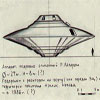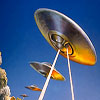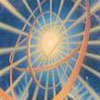A Spaceman Speaks On The Nature Of Light
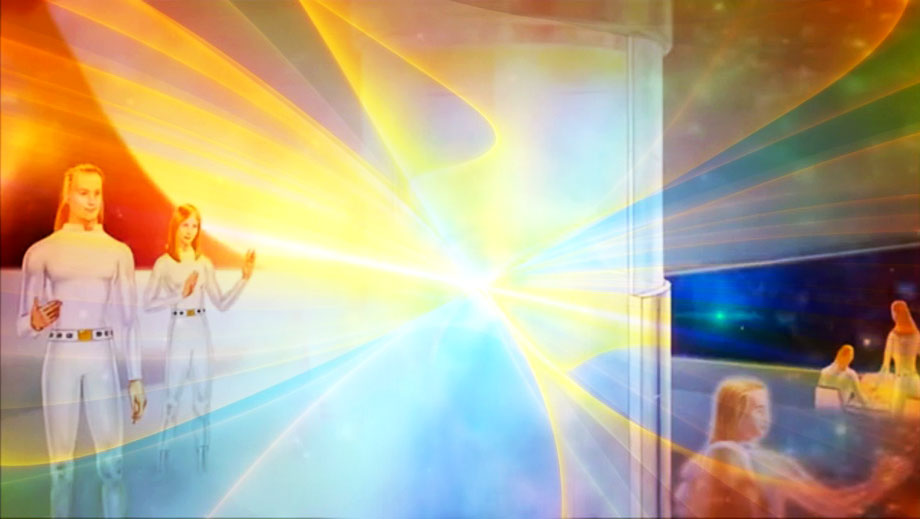 by Dino Kraspedon
by Dino Kraspedon
Q: Taking your theory that light of the sun repels bodies in space, and that the tides are caused by the force of this light reflected from the moon, why is it that the earth’s velocity in orbit increases when the moon crosses this orbit ahead of the earth, and decreases when it crosses it in the earth’s wake?
A: When the moon is ahead of the earth, it is obvious that the pressure of light gives an impulse to the surface of the moon. As the moon is within the earth’s magnetic field, this impulse is transmitted magnetically back to earth as though it were impelling the earth from the rear. This is like a system of transmission of forces. The opposite happens when the moon crosses in the wake of the planet. When the light presses upon it, it is as though it opposed the earth.
Q: You told me that if a comet approached the earth against the direction of the earth’s rotation, it would be shattered. However, it seems that comets avoid approaching other bodies, since those that come too close to the satellites of Jupiter are deflected. Why?
A: This is again due to the force of repulsion which light exerts upon bodies. The light from the satellites does not only fall upon the planet, but goes out in all directions. Each satellite acts as a mirror on the comets, which are deflected by their joint effect, and are forced to change direction.
One particular comet, for instance, approached the sun and was at the same time repelled by it. This resulted in an acceleration of 1,400 miles per second.
Everything depends upon the speed with which one body approaches the other, and the position of the satellites at that moment. If the direction of the approaching body is such that it receives the effective light of the satellites at an angle, then it will be deviated from its path, but if this light meets it anywhere near head on, then the comet will quite probably reach the planet, having sufficient acceleration to overcome the repulsive force of the light.
This is what happened to Saturn. A comet entered the solar system, demolished a satellite in its path, and both satellite and comet were transformed into a huge ring. The fragments of the comet and of the satellite can still be seen in this ring, forming concentric circles according to the density of their matter.
Q: You spoke, also of an envelope of ether around the earth; however, Michelson, in his famous experiment, found no ether.
A: He found none, nor could it be found. The retardation which he thought to find in the speed of light, owing to the resistance of the ether, could not exist if the ether moves with the same angular velocity as the earth. When two bodies develop identical velocity in the same direction, they remain in the same relative positions. It does not matter what the speed is to an observer outside the system; it is a question of relative velocity between two points in the same system. A mass M may rotate at any speed; the important thing is to observe whether two points of the mass move at different speeds. The most difficult problems can be explained with the simplest illustrations. If a fly takes off from the rear of a bus traveling at high speed, and flies to the front in 15 seconds, would it take more than 15 seconds for it to fly back to the rear of the bus?
Q: No, it takes the same time because it is flying inside the vehicle.
A: Exactly, it takes the same time. Let us now suppose that one person is seated in the rear and another in front; the one behind throws a ball to the other in front, who returns it. If the ball is thrown with the same force in each direction, it should take the same time to go as it takes to come back. You see that the speed of the bus is external, that is to say in relation to points outside the bus. Inside the bus there is no speed. Michelson should have reasoned his experiment out in the same way; light being like the ball going from one part of the bus to another, without any loss of speed. It could no more be retarded in relation to the ether than the ball in relation to the atmosphere. It is as though one were to say there is no atmosphere because it did not cause the ball to lose velocity when the bus was traveling at high speed.
However, Michelson is not to be blamed. The blame lies with those who thought that the ether was universal and stationary in relation to earth. On this false premise, anybody would have come to the same erroneous conclusion. If a minor premise in a syllogism is wrong, the conclusion is wrong, just as it is if a major premise is involved. False theories produce wrong results. As far as that experiment was concerned, it was a false premise on which the people of earth have elaborated a whole theory. We must therefore go back to first principles.
Speed of Light
Michelson found a constant for the speed of light. Is this constant correct? The answer is no. If he found that the ether had no retarding effect on light, it was because:
1) There can be no retardation in the movement of a body if all points of its mass move with the same speed. That is to say that ether has the same impulse as light, less its velocity.
2) The medium was a homogeneous one.
3) The basis of measurement was very small (12 yards).
4) Retardation of light due to the resistance of the medium should be sought by comparing two different media, say air and water.
5) Light is only visible on the planet if it has a speed of 186,000 miles per second.
Let us take this a stage further; the resistance which Michelson sought and did not find is to be found in a mirror which reflects light, because a resistance is set up by the barrier, in this case the mirror, in the process of reflection. In water, for example, the reflection is never complete because part of the light is absorbed. This shows that there is pressure, resistance and absorption. On looking at the moon, we notice that this reflected light is softer. In this case some of the visible light falls to a lower frequency and becomes visible on account of this resistance by the barrier.
It depends on what we call light. Something which is darkness for you may be flooded with light for me. A simple pressure on the eyeball or the optic nerve can demonstrate this fact. There are species of animals which see in another frequency range and for them night is day and vice versa. Infrared rays are a form of invisible light and their speed is much less than that of visible light. Again, chemical, actinic or ultra-violet rays are invisible light and travel with much greater speed than visible light, as they have much higher frequencies; that is, always assuming that the speed equals frequency times wavelength.
If we say that visible light travels in space with a speed of 186,000 miles per second, we should be right; but we should be wrong if we thought that this speed constant applied to waves of different frequency ranges.
We must consider certain aspects of the problem. For their propagation, these rays require a medium adapted to their wavelength and frequency. Heat rays, or infrared rays, require a dense medium, for they cannot pass through the vacuum. Visible light can travel in a semi-vacuum and in a dense medium to a certain extent, but not as well as infrared rays do.
In an absolute vacuum there is no propagation of light. This can better be seen in the so-called holes in space, such as the “Coal Sack” in the Milky Way. In a Geissler tube, also, it can be seen that light ceases to cast a shadow when the pressure within the tube is very low. However, a vacuum is the ideal medium for the propagation of waves above the frequency of visible light.
An Atmosphere Protects
Looking at the problem in this way, the light that reaches the earth’s surface is modified. If this were not so the chemical rays would destroy life on earth. Behold the wisdom of God, who protects planets close to the sun by giving them a cloak of dense atmosphere and ether, and gives those distant ones, whose speed of revolution is low, a thin covering.
The modification of solar light can be seen at sunrise or sunset, when it is red, whereas at midday it is white. This modification from white to red takes place over a distance of 6,758 kilometers, equal to the equatorial radius of earth, which is the extra distance the light must travel to reach the observer, compared with the light at midday. While the latter has to penetrate 400,822 km of ether, the light of the rising sun has to travel 407,200 km. Between white and red light there is a difference of 30,000 mgcs per second. If the light loses 30,000 mgcs in 6,758 km, how much will it lose in 407,200? If the wavelength remains the same and the frequency is considerably increased, this must mean that the waves from the sun reach the earth’s etheric covering at a much higher speed as shown by the formula below.
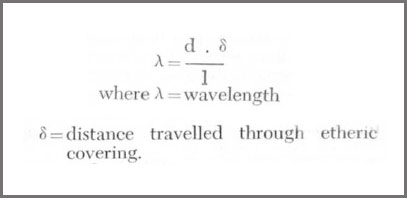 We can see the same thing in the difference of the speed of light in the atmosphere and in water. It is only 140,000 miles per second in water, as opposed to 186,000 in the atmosphere. Therefore, density has a considerable effect on its speed.
We can see the same thing in the difference of the speed of light in the atmosphere and in water. It is only 140,000 miles per second in water, as opposed to 186,000 in the atmosphere. Therefore, density has a considerable effect on its speed.
Light which becomes visible on reaching the earth’s surface reaches the etheric envelope of the earth at a speed of 6,250,000 miles per second; and light that is above the visible spectrum on reaching the earth arrives at far higher speeds. For the sun emits its energy at various wavelengths and at different frequencies. Its emission is never uniform.
We have reached a point where we can say that the light of the sun exerts on earth a pressure equal to the weight of light, measured at the earth’s surface, plus the energy lost in traversing the 400,000 km of etheric mass. If we consider that the effect is twofold, since this “fatigue” of light is progressive or in geometrical progression, we can arrive at an approximate idea of what that means.
Q: Why a twofold effect?
A: Because, as light loses weight its frequency falls correspondingly and this, in turn, is a factor.
Having thus obtained the pressure of solar light, the reasoning that earth’s stability in orbit is due to the equilibrium between the forces of attraction and repulsion, it is evident that the magnetic field that causes the attraction must exactly counterbalance the force of repulsion, and we can then determine the flux density of the magnetic field.
Excerpt from My Contact With Flying Saucers
Posted in Other Topics, Science For The New Age, UFOswith comments disabled.


